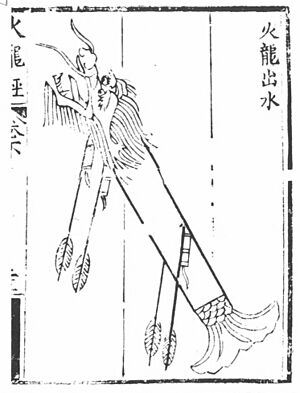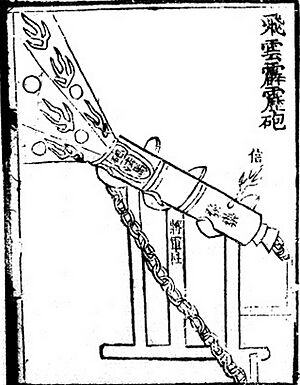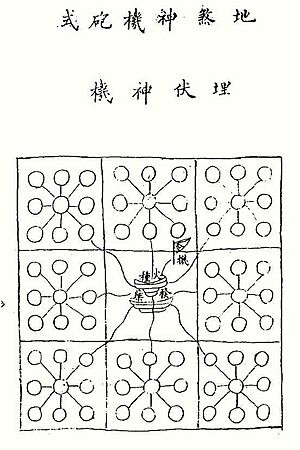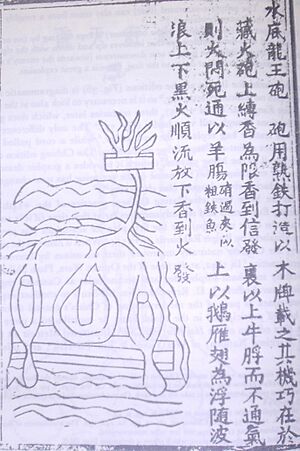Huolongjing facts for kids
The Huolongjing (which means Fire Dragon Manual) is an old Chinese book about military weapons. It was put together by two people, Jiao Yu and Liu Bowen, during the early Ming dynasty in the 1300s. This book is mostly based on an even older text called Huolong Shenqi Tufa, which is now lost. The Huolongjing is a super important guide to how people used "fire weapons" and gunpowder a long time ago.
Contents
History of the Fire Dragon Manual
The Huolongjing was made to be a guide for using weapons that involved gunpowder between the 1280s and 1350s. The original book it came from, Huolong Shenqi Tufa, is now gone. The Huolongjing is the only one of three important military books from the early Ming period that still exists today.
The first version of the Huolongjing was written by Jiao Yu, a general in the Ming army, sometime between 1360 and 1375. The book's introduction was added later, in 1412. This 1412 version, called Huolongjing Quanji (meaning Complete Collection of the Fire Dragon Manual), is very similar to the first one. Jiao Yu wrote in the introduction that he was describing gunpowder weapons used since 1355. He was involved in a big rebellion against the Yuan dynasty. Jiao Yu made firearms for the first Ming emperor, Zhu Yuanzhang. He later became in charge of the Shenjiying armory, which was a place where all the firearms were kept.
Two more parts of the Huolongjing were published in 1632. These new parts described weapons like the musket and cannons that loaded from the back. After the Ming dynasty ended, the new Qing dynasty stopped people from printing the Huolongjing. This was because it used words like 'northern barbarians', which offended the ruling Manchu people.
What's Inside the Book?

Gunpowder and Explosives
For a long time, gunpowder was known as a "fire-drug" because it was first used for medicine. But by the 11th century, people realized how powerful it was. The Chinese government started controlling gunpowder production. They even banned people from selling sulfur and saltpeter, which are key ingredients.
By the late 12th century, Chinese gunpowder was strong enough to make things explode and break open iron shells. They made it even stronger by adding sulfur from pyrite. By the 14th century, Chinese gunpowder was at its most powerful. There were at least six formulas for making explosive gunpowder. These formulas had different amounts of nitrate, from 12% to 91%.
The Huolongjing's main new idea for gunpowder was using it as a chemical weapon. Jiao Yu suggested new gunpowder mixes beyond the usual saltpeter, sulfur, and charcoal. He described "divine gunpowder," "poison gunpowder," and "blinding and burning gunpowder." Poisonous gunpowder for bombs was made with things like tung oil, urine, and even feces. Jiao Yu said that "even birds flying in the air cannot escape the effects of the explosion."
One explosive device was the "flying-sand divine bomb releasing ten thousand fires." It had a gunpowder tube in a pot filled with quicklime and poisonous plant extracts.
Fire Arrows and Rockets
Jiao Yu called the first fire arrows shot from bows "fiery pomegranate shot from a bow." This was because the gunpowder-filled paper wrapped around the arrow looked like a pomegranate. He said to use hemp cloth to make the paper stronger and seal it with melted pine resin. Fire arrows were mentioned much earlier, in 1126, when 20,000 of them were given to invaders. An even older book from 1044 described using special bows that fired arrows with gunpowder.
Later, the term "fire arrow" also meant the first rockets in China. Instead of a bow, people used a hollow tube to shoot gunpowder-filled arrows. The historian Joseph Needham believed this happened before Jiao Yu's time.
The Huolongjing describes these early rockets:
One uses a bamboo stick 4 ft 2 in long, with an iron (or steel) arrow–head 4.5 in long...behind the feathering there is an iron weight 0.4 in long. At the front end there is a carton tube bound on to the stick, where the 'rising gunpowder' is lit. When you want to fire it off, you use a frame shaped like a dragon, or else conveniently a tube of wood or bamboo to contain it.
In the late 1300s, rocket launchers were combined with fire lances. This meant three tubes were attached to one staff. The first rocket would fire, then a charge would light in the next tube, releasing a blinding powder. Finally, the second rocket would fire. The Huolongjing shows pictures of this and explains how it confused enemies.
The book also shows and describes two types of rocket launchers that fired many rockets at once. One was a round, basket-like launcher, and the other was a rectangular box launcher. Some rockets in the Huolongjing even had artificial wings to help them fly straight. Jiao Yu said these rockets could fly hundreds of feet high before hitting their target.
The Huolongjing also describes the oldest known multistage rocket. This was the "fire-dragon issuing from the water" (huo long chu shui), used by the Chinese navy. It was a two-stage rocket. The first stage (booster rockets) would light up smaller rockets that shot out of the front, which looked like a dragon's head. Some historians think this multistage rocket was the ancestor of modern cluster bombs.
Fire Lance
The fire lance was a weapon that was a mix of a firearm and a flamethrower. By the time Jiao Yu edited the Huolongjing, it had changed into many forms. The earliest picture of a fire lance is from around 950 AD. These early fire lances were made of bamboo tubes. Later, in the 1200s, metal barrels appeared. These shot gunpowder flames along with small objects like porcelain pieces or metal scraps.
Some of these flamethrowers used poisonous mixtures, like arsenious oxide, and would spray porcelain shards like shrapnel. Another fire lance in the Huolongjing was called the 'lotus bunch'. It shot arrows along with a fiery blast.
The Huolongjing also shows a tall, mobile shield used to protect soldiers. It was called the "mysteriously moving phalanx-breaking fierce-flame sword-shield." This large, rectangular shield was on wheels. It had holes where fire lances could be placed. Swordsmen would stand on either side to protect the gunmen.
Cannons and Guns
In China, the first picture of a cannon barrel was a stone carving from 1128. The oldest cannon that still exists with a date on it is a bronze cannon from 1298. The oldest confirmed cannon is the Heilongjiang hand cannon, from 1288. History books say that in 1288, a Chinese commander used hand cannons and small cannons to stop a rebellion.
Before metal barrels, cannons were made of bamboo. One of the first times a cannon's destructive power was mentioned was in 1341. A writer said its cannonball could "pierce the heart or belly when it strikes a man or horse."
Jiao Yu described the cannon, called the "eruptor," as a bronze device about 53 inches long. He wrote that some cannons were filled with about 100 lead balls. Others, called the "flying-cloud thunderclap eruptor," had large rounds that exploded when they hit something. The ammunition was hollow iron shells filled with gunpowder to create an explosion. He also mentioned a "poison-fog divine smoke eruptor." This cannon fired shells filled with "blinding gunpowder" and "poisonous gunpowder" to burn enemies' faces and eyes, and choke them with smoke. Cannons were put on frames or wheeled carts so they could be moved and aimed.
The Huolongjing also shows a hand-held gun with up to ten barrels. This was like an early machine gun. During the time of the Yongle Emperor (1402–1424), a special military group called the Shenjiying used these new firearms.
The first time land mines were used was in 1277. An officer named Lou Qianxia is given credit for inventing them. He used them to kill Mongol soldiers. Jiao Yu wrote that land mines were round, made of iron, and exploded when enemy movement triggered them. He mentioned using steel wheels as the trigger. A later book from 1606 showed how the steel wheel trigger worked. It used a pin, weights, and cords to spin a steel wheel against a flint, creating sparks to light the mine's fuse underground.
Here's how Jiao Yu described a land mine:
The explosive mine is made of cast iron about the size of a rice-bowl, hollow inside with (black) powder rammed into it. A small bamboo tube is inserted and through this passes the fuse, while outside (the mine) a long fuse is led through fire-ducts. Pick a place where the enemy will have to pass through, dig pits and bury several dozen such mines in the ground. All the mines are connected by fuses through the gunpowder fire-ducts, and all originate from a steel wheel (gang lun). This must be well concealed from the enemy. On triggering the firing device the mines will explode, sending pieces of iron flying in all directions and shooting up flames towards the sky.
For naval mines, Jiao Yu wrote about slow-burning incense sticks that were hidden. They were timed to explode when they reached enemy ships.
The sea–mine called the 'submarine dragon–king' is made of wrought iron, and carried on a (submerged) wooden board, [appropriately weighted with stones]. The (mine) is enclosed in an ox-bladder. Its subtlety lies in the fact that a thin incense(–stick) is arranged (to float) above the mine in a container. The (burning) of this joss stick determines the time at which the fuse is ignited, but without air its glowing would of course go out, so the container is connected with the mine by a (long) piece of goat's intestine (through which passes the fuse). At the upper end the (joss stick in the container) is kept floating by (an arrangement of) goose and wild–duck feathers, so that it moves up and down with the ripples of the water. On a dark (night) the mine is sent downstream (towards the enemy's ships), and when the joss stick has burnt down to the fuse, there is a great explosion.
Later, in 1637, another book described a naval mine where the ox bladder was replaced with a lacquer bag. The fuse was lit by a cord pulled from someone hiding on the shore.
Legacy of the Huolongjing
Gunpowder weapons were used a lot during the Song dynasty in China. These weapons changed a lot over time, leading to the invention of the cannon. Cannons were first used during the Mongol Yuan dynasty to fight rebels. Cannon development continued and became even more common during the Ming wars.
Chinese cannons became very advanced. The "great general cannon" could weigh up to 600 kg (about 1,320 lbs) and fire many iron balls at once. These were the last Chinese cannon designs before European cannons arrived in the 1500s.
When Portuguese explorers came to China in the early 1500s, they thought their own firearms were better than China's. European guns like the arquebus and matchlock became more advanced than earlier Chinese firearms. However, by the 1600s, Vietnam was making muskets that the Ming Chinese thought were even better than European or Ottoman guns. These Vietnamese firearms were quickly copied and spread throughout China.
Images for kids
See also
- Technology of the Song Dynasty
- Jiao Yu
- Liu Bowen
- Gunpowder warfare
- History of gunpowder
- Battle of Tangdao
- Battle of Caishi
- Wujing Zongyao, a Chinese military book written around 1040 to 1044.
- Jixiao Xinshu, a Chinese military manual written during the 1560s and 1580s.
- Wubei Zhi, a Chinese military book compiled in 1621.







































